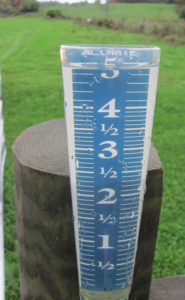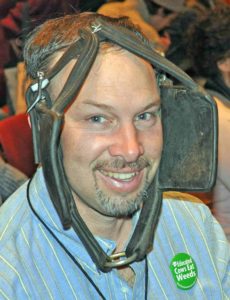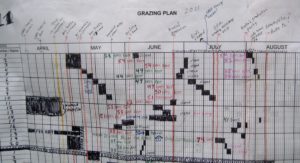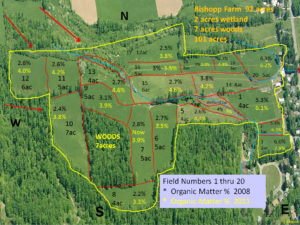Grazing Management in the New Normal
As a veteran grazier, I’m concerned about the phrases, “The 300 year flood, Peak Soil, Peal Oil, Climate Change and The New Normal” frequently heard in the news. Should I discount them as just an anomaly or should I be planning on how this will affect my grazing operation?

5 inches of rain seems to be the ‘new normal’
For me, it boils down to a simple concept; keep the soil covered with perennial, highly diverse, biologically active pastures. However it has taken me 48 years of farming to become a true believer and holistic planner in this. It’s rather embarrassing to admit I missed this mark as a “yute” while continually being stumped by a grazing system always headed in the path of what Andre Voisin termed; untoward acceleration, where each successive grazing period provides less forage and the rest period is shortened until the rotation collapses. Grazing Consultant, Jim Gerrish, says grazing too short is the biggest problem in production.
With hairline receding and the prospect of a sixth generation farming here, I found the “ah ha” moment I needed 12 years ago in a hurricane and in the mirror. The forces came together after a long dry spell followed in earnest by a 5 inch rain. As I flashed a picture of my swollen, muddy stream, I turned the lens to wipe off the rain and I caught my reflection, this was my fault.
This single event of losing topsoil put me on the path to become a better grazier and in turn a better land manager. But I needed a better plan, more measuring and monitoring and long term goals. I am lucky to live in an era with access to knowledge from influential grazing notables; Andre Voisin to Newman Turner, Darrell Emmick to Jim Gerrish and Allan Savory to Greg Judy to name a few. This has led me to think about grazing in a more holistic, management-driven style predicated on a triple bottom line mentality and stop blaming the animals for over-grazing.
“Create the farm you want” is a quote I like in approaching the upcoming grazing season. Like any good game of chess, it starts with a tactical plan. I start by planning (hypothetically) on my 12 month grazing chart (in pencil) before I go into Mother Nature’s domain, around specific financial, production, environmental and family goals. I plan in recovery periods, certain grazing strategies for each field, expected dry matter intakes and plan back from major events such as my daughter’s wedding, droughty times, breeding, bluebird fledging, frost and stockpiling dates. This futuristic decision-making and constant monitoring allows me to think deeply about what’s ahead and works nicely with my experience and gut feelings to make management changes sooner and level out the new normals of weather.
You’re probably thinking, easier to plan than to implement. But the impetus for the organic farmer is if you run out of grass you’re out of options. We’ve got to get in the mindset that it takes grass to grow grass and stop being scared of wasting a little grass if you want top performance for your animals and soil. I do agree that the forage should be trampled, harvested or clipped sixty days before the first frost to enable possible extended grazing of rested plants.
My observations over 26 years of grazing on our farm are this; rain now comes down in buckets and we need to catch it all for the uncharacteristic dry periods that are happening. On our farm, the shorter always vegetative sward of plant species of yesteryear has given way to a taller, more mature grazing style with a higher grazing residual (4”) and in turn longer rest periods, averaging 45 days for last season. This has changed my naturalized sward into having a more prairie-like composition which have deeper, stronger roots and puts more litter on the ground to feed the soil microbes.
Having stronger, more vibrant plants has also increased our grazeable days by two weeks in the spring and two months in the fall. This strategy in conjunction with stockpiling has raised our farm’s organic matter from 3.4% to 4.6% over the last three years which has essentially drought-proofed the farm while sequestering the big rain and adding resiliency to the whole farm system without buying expensive inputs.

I’m wearing blinders to stay focused on grazing management
I’ve been monitoring Brix levels of plants and the cows that eat them and continue to see higher energy levels in more mature swards later in the day especially in young blossoms and leaf tips. To garner more of this production, I move animals 1/3 of an acre in the morning and 2/3 in the afternoon. The difference can be 7 brix in the early morning and double that by 3pm. Capturing this free energy just takes moving a fence. I’m also hearing many farmers having good success spraying raw milk on pastures to raise the energy.
Grazing for energy and not towards Jerry Brunetti’s “funny proteins” has been a learning curve, but also good for the wallet as it takes less expensive grain and baleage to even out the animal’s diet and production. At the same time it allows the plant roots to rest and add mass in the soil which stimulates soil life and increases water holding capacity.
Probably the most often overlooked questions of grazing management in the new normal are: What are you managing towards and why? Without tangible sustainable goals, you may fall prey to buying prescriptions that fix problems not address root causes.
In my humble opinion, making money from grazing is absolutely about keeping the soil surface covered with diverse swards and soil life collecting solar energy while sequestering moisture and carbon. One only has to remember 2011 to see this is a great strategy for the future.
How do you get it done? Create farm family goals that incorporate the triple bottom line, plan out in detail how to make these goals happen, question everything, measure and monitor progress often, join a mentoring team, record your results and most of all have fun honing your grazier’s eye because the world needs more pasture-based systems.




It is 2021, and I hope your pastures are still thriving, as well as you.
Interesting insights into your grazing management approach. The emphasis on holistic planning diverse pastures and the connection between soil health and resilience is inspiring. Your experience highlights the need for proactive strategies in the face of changing weather patterns.
Kitchen Remodeling Services in Seattle WA